Mind Streaming
John Coxon's Online Journal|
Archive Search |
| Links |
|
and s-integrator |
Thursday, June 12, 2003
A Typical Anglican Parish Church
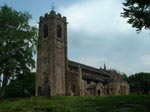
The church, with its extensive graveyards,of St. Mary's parish church in Prestwich, near Manchester, has been a local landmark for centuries.With its extensive, partly wooded graveyard, on the south and west facing slopes of its grounds , it is one of my favourite tranquil places to visit and walk around. It is so full of interest. St Mary's is very typical of so many of the prolific local English parish churches that populate the English countryside providing a visible sense of stability and continuity of community, even though for many, congregations have diminished.
There was, according to local records, a place of worship on this site as far back as 1145 A.D.
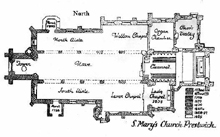
The current building is hard to date precisely as it is an historical composite of various additions to it made over a number of centuries. This plan of the church shows details of the layout and the various ages of different sections of the building, starting from the 15th century.
As you come into the grounds through the iron gates opposite the Church Inn pub,
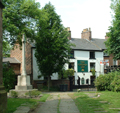
to your right is an outhouse that was originally the town mortuary in the 18th century.

To your left is a set of stone steps, used, originally by members of the congregation who rode horses to church, to mount and dismount. The church itself is predominantly constructed in a rose-red coloured sandstone; there is some very old graffiti, very well carved, on the west walls, some dating from the time of Nelson.
The oldest gravestone in the church ground dates from 1641 and is the last resting place of the children of one Thomas Collier whose children were buried "bewtixt the 1st and the of 12th of December" in that year.
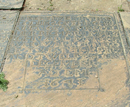
It seems likely that Thomas Collier may have carved their headstone himself. You can see the lettering style changes that indicate someone not used to carving in stone and it adds to the poignancy of what was a family catastrophe.
Like many parish churches, St Mary's is built on a hill, emphasing the importance and indeed power of the Church , especially in former times, and of course, enabling the church tower bells to be heard from miles around.
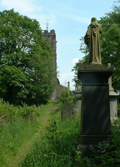
Whilst the majority of the headstones seem to be from the Victorian and Edwardian era, there are many more recent. On the small grassed areas on the eastern and south western sides of the building are a number of small, horizontally laid stones under which are interred the ashes from more recent cremations. I have chosen this example because I know the mason who carved the lettering.

Thisbeautiful gothic script is the work of local stone mason, Arthur Atherton, whose workshop I once had the privilege to visit. (He generously gave me one of the stone carving chisels he used as a souvenir , something I cherish.) Arthur's style is very distinctive. I can easily identify the numerous examples of his work all over the graveyards. He learned this style, during his apprenticeship, from a Victorian mason. Whilst most monumental masons these days charge higher fees for elaborate scripts, Arthur does not because that is his personal style ; the one he's always used and continues to use.
Within the graveyard are a number of soldiers graves, easily spotted because the majority have been fashioned from white Portland stone (a white limestone which does not stand up too well to the atmosphere and climate in these parts and many are weathered quite badly.) The shape of military head stones is uniform. The tradition here is to carve a cross, the serviceman or womans' rank, serial number, the name of the regiment and the regimental badge and the precise date of death.
Many of the old local regiments represented here now no longer officially exist as they have been merged into larger regiments. One of the soldiers is a Canadian Infantryman, Private G.H.Longstaff, ( died 29th April , 1917.) There is one female military grave, that of Beatrice Slack (died 2nd June 1946) who was in the ATS ( Auxillary Territorial Service -as was my mother incidentally)
There are just two graves of RAF servicemen amongst the military people buried here. Seargeant W.S.Wadsworth ( died 5th april , 1942) .
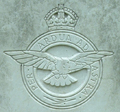
There is also the headstone of RAF Sergeant J.T. Anderton (died 11th June , 1943) but the excellent condition of the stone suggests that it is a recent reburial, since the gravestone of RAF Sergeant Wadsworth has damage from weather erosion which suggests that stone has been there since 1943. One possibility is that, for example in Holland, aviation archaeologists and historians have been tirelessly excavating the wreckage of Second World War aircraft and going to great lengths to identify and then repatriate our WW2 aircrew. You notice that Sergeant Anderton was a wireless operator/gunner, and there were terrible casualty figures amongst crew who fulfilled that dangerous roll in Bomber Command over Europe.
Recently, it appears, someone has been working hard throughout the church grounds clearing the weeds and brambles from around all the military graves, whilst, the majority of often impressive, predominantly grey, Victorian and Edwardian stones remain partly obscured by high weeds and brambles.
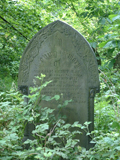
There is a poignant site in the north west side of the churchyard where, as if lined up for the final parade, are the stones of twelve men who died during the First World War. These stones are made of a tougher, darker stone and have weathered well in comparison to those fabricated from Portland Stone.

I always go over to these graves when I visit this grave yard and one of the stones saddens me because it simply marks that the remains of Private T. Anderson of the Manchester Regiment were "buried in this churchyard" but where ?
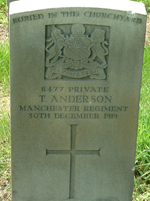
Anotherthing you notice in the graveyard is that many of the graves (of probably more eminent local residents) clearly had cast iron railings around them or cages over them, possibly to prevent the theft of bodies at a time when illicit premiums were paid by those , in the early days of medicine and surgery , wanting bodies to study human anatomy.
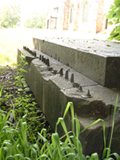
There is , however only the stub remnants of these metal railings because, very probably, the metal was taken away to be melted down during the WW 1.
During my days teaching very disturbed children, I used to bring them, with gardening tools, to the churchyard and we would spend happy hours clearing brambles and weeds from headstones. The church has many beautiful, original stained glass windows, and inevitably then, before protective grills and outer tough glass were put on to protect them, some idle fools from nearby would damage them with stone throwing. We used to scratch around under the windows for fragments of the old glass left by the glaziers.
( I remember one time, we were in the church grounds when we met , somewhat incongruously, an American couple. The lady had been married in this very church before she emigrated to America. She had been very emotional and moved at coming back to visit St Mary's with all the memories it held for her. I struck up a friendly conversation with her and explained why we were there. Realising how important the place was to her, I went down on my knees and scratched around in the grass by the church wall and found what I wanted and knew she would appreciate ; a small fragment of original glass from one of the stained glass windows that had been repaired. She wept when I gave it to her and talked excitedly about having it mounted as a pendant by a jeweller when she got back to the states. I felt very happy about that.)
Part of the lower graveyard on the south facing slope is wooded. Just the other day, on my last visit, I spotted a rare sight ; a beautiful Jay, hopping from tree to tree as I tried to line up for a photograph. The bird clearly was not keen to have his portrait taken an and led me a merry dance ; in the end I had to give up the idea.

Thereare numerous huge, gorgeously purple mature Rhododendron shrubs in the church yard, probably dating from mid-Victorian times when they were popular shrubs in so many gardens. As you leave the church grounds, there is a tall 'cross of sacrifice', bearing a replica of huge bronze sword and commemorating the fallen of the two great wars.
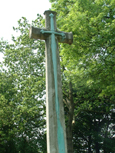
The sword on the west side of the cross is missing, either stolen or fallen off and never replaced. This Portland stone cross is badly weathered and it is almost impossible to make out the inscriptions.
johncoxon 7:34 AM - [Link] - Comments ()
...